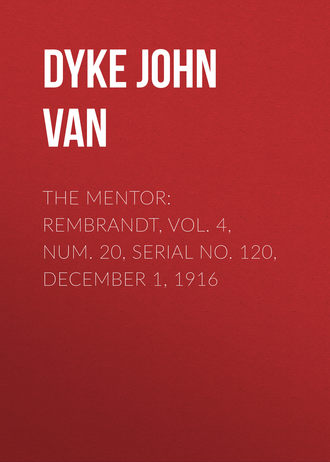 полная версия
полная версияThe Mentor: Rembrandt, Vol. 4, Num. 20, Serial No. 120, December 1, 1916
REMBRANDT Verhaeren (Les Grands Artistes), Paris.
REMBRANDT Vosmoer Paris, 1877.
REMBRANDT Valentiner (Klassiker die Kunst), Stuttgart.
REMBRANDT, A STUDY OF HIS LIFE AND WORK Brown New York, 1907.
⁂ Information concerning the above books and articles may be had on application to the Editor of The MentorTHE OPEN LETTER
“Why are pictures repeated,” asks one of our readers. We rarely repeat a picture, but we do print more than one picture of the same subject – and for a most excellent reason: The Mentor is not through with a subject in one number. That would be a poor and meager educational service. The plan of The Mentor Association is to present subjects to its members in various ways, so that they may consider these subjects from different points of view. This is done so as to give the reader a broad, comprehensive grasp of things. Let me illustrate. The Taj Mahal is one of the most beautiful buildings in existence. When, therefore, we published The Mentor on “Beautiful Buildings of the World,” we printed, of course, a picture of the Taj Mahal. When we came to the subject of India in Mr. Elmendorf’s series of travel numbers, we could not overlook the exquisite Taj Mahal – which is one of the sights of India. We shall later on have a number of The Mentor on Oriental Architecture. The Taj Mahal being one of the finest examples of oriental architecture, cannot of course be ignored in that number simply because we printed two pictures of the building in former Mentors. In each case the reader is asked to consider the Taj Mahal from a different point of view. And, moreover, we do not repeat the same picture. We print three different views of the Taj Mahal.

Another instance. We printed in The Mentor devoted to “Masters of the Violin” a very fine portrait of the Spanish violinist, Sarasate. This picture not only happens to be a most interesting portrait of the great violinist, but it has a special art value in having come from the brush of Whistler. Next year we shall devote a number of The Mentor to the work of James MacNeil Whistler. When we do so it will be impossible for us to ignore this wonderful portrait of Sarasate, for it is a distinguished example of Whistler’s art. The present number is another case in point. We have considered Rembrandt’s art several times in The Mentor. He occupied a prominent place, as you know, in the number devoted to “Dutch Masterpieces.” He also appears in the number on “The Wife in Art.” And now we devote a number exclusively to him.
The basic idea of The Mentor is a broad one. We do not consider that a subject, once treated, must be boxed up and shelved. Oh, no! While we make our excursions into the different fields of knowledge, we shall often turn our faces back to some great subject of interest that we have already observed and consider it anew from a different point of view.

When you write to The Mentor always sign your name and address. The old time-worn signatures of “Reader” or “Friend” make it hard for us to give Mentor service. The following came into the office a few days ago:
“Have greatly enjoyed your Mentor this last year. One suggestion I would make, though, is relative to the Madonna Ansidei. That famous painting was purchased by Morgan a number of years ago. In 1910 it was in the National Gallery, as a loan, and at present is in the Metropolitan Museum, New York, one of its greatest treasures. Ought our public to be informed by The Mentor that it is in London?”
A Reader.Where our reader got the notion that the Ansidei Madonna is in the Metropolitan Museum of Art, in New York, I am at a loss to understand. If that famous work had ever been brought to America, surely the whole world would have known of it. Works of art of such importance are not moved about without the public being advised of it. The Ansidei Madonna is in the National Museum, London, and the circumstances of its being placed there are exactly as stated in The Mentor. It was purchased for the National Museum from the Duke of Marlborough’s collection for about $350,000. The Raphael Madonna, in the Metropolitan Museum of Art, that our reader refers to, is known as the “Madonna of St. Anthony of Padua.” I hope that this will catch the eye of our friendly reader, and especially I hope that he will not continue to entertain the thought, or impart it to others, that The Mentor is giving the public incorrect information concerning the Ansidei Madonna.

W. D. Moffat
Editor



